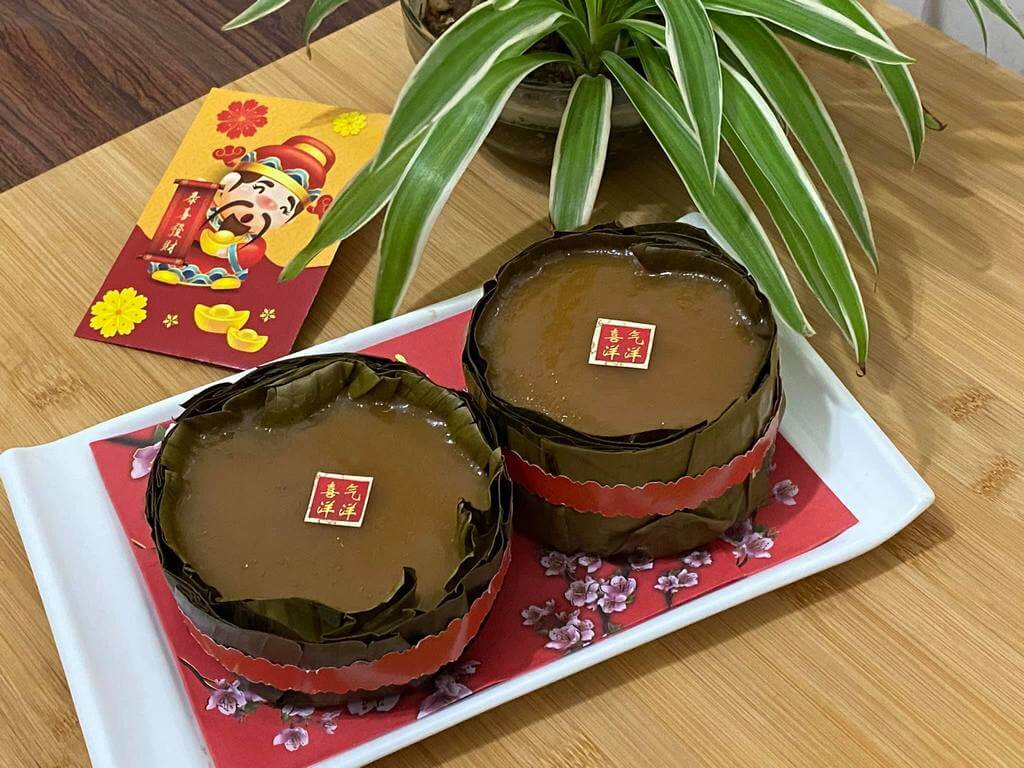MUST-HAVE Traditional Chinese New Year Food! There are certain food which plays a very important role in the celebration of Chinese New Year.
In this Spring Festival, there are several foods which have names with great symbolism in it; making them essential, and special, for an auspicious year ahead.
- Nian Gao (Sweet Glutinous Rice Cake/Kueh Bakul)
“年糕” (Nian Gao) or also known as New Year Cake is made of glutinous rice flour.
It is sweet and has a dense and sticky texture. “年” (Nian, Year) symbolizes “粘” (Nian, Glutinous), which is also a homophone for the word “sticky”, and “糕” (Gao, Cake) symbolizes “高” (Gao, High).
So, when combined, “年高” (Nian Gao) means to have a higher success in the new year ahead.
There is also another version behind the reason for eating nian gao during Chinese New Year.
Most of the Chinese community believe in “Kitchen God” in every household. The Kitchen God is said to conduct an annual report of the family to the celestial gods.
And we offer Nian Gao to the Kitchen God with hopes that the sticky texture of the cake will refrain the Kitchen God from reporting the unfavourable things we’ve committed throughout the year.
- Whole Fish
Fish is pronounced as “鱼” (yú) in Mandarin which is similar to the pronunciation of “余” (yú, leftover) giving the meaning of having a surplus of food and wealth that we can bring forth towards a better year.
- Whole Chicken
Serving a whole chicken symbolizes the reunion of the whole family.
- Oranges
Oranges and tangerines are said to bring luck and prosperity for the New Year since their names in Chinese sound like “luck” and “wealth”.
Their bright, vibrant orange colour is also associated with good fortune. Get to know more about the meaning of the vibrant colours of Chinese New Year.
Oranges and tangerines are often served at the end of the meal and also exchanged when you visit relatives.
- Dumplings
Dumplings have a similar look to the gold ingot (money used in ancient times), hence it represents prosperity.
Now that we have understood the “celebrity food” for Chinese New Year, allow me to share the secrets of making Nian Gao the easy way.
Traditionally, nian gao takes hours or even days to make. But these days, with the help of pressure cookers, it can be done in a shorter time, sometimes in hours.
However, I’m going to share how to steam Nian Gao using an ordinary steamer for the benefit of all who doesn’t have a pressure cooker in their homes.
What Do You Need to Make Nian Gao
Traditional way vs the Modern way
The traditional way of making nian gao is to mix glutinous rice flour, water and sugar and steam it for hours, or days, until the sugar is caramelised, resulting in a beautiful golden sticky texture, which would then be moulded into the shape of a cake.
The modern way, however, cuts down the steaming time to 2 hours, as sugar is caramelized before adding flour, hence saving time and energy in steaming it for long.
First, this is how you should lining the mould with banana leaves.
Lining the mould with banana leaves.
Now, this is how can you prepare the nian gao batter:
Quick and Easy Nian Gao (Kuih Bakul) Recipe
Equipment
- Pressure Cooker
Ingredients
- 350 ml water boiled with pandan
- 250 g glutinous rice flour
- 150 g brown cane sugar
- 70 g gula melaka
- 1 tsp oil
Instructions
- Boil 400ml water with pandan leaves until fragrant.
- Keep boiling until liquid is reduced to 350ml.
- Pour through strainer to remove pandan leaves and set aside.
- In a clean pot on low heat, melt 150g brown cane sugar with 70g gula melaka.
- Pour pandan water bit by bit into the caramelised sugar.
- Keep adding pandan water until all caramelised sugar is diluted.
- Turn off the heat and pour through strainer.
- In a mixer, gradually pour sugar mixture into 250g glutinous rice flour and mix until smooth.
- You can also use a hand whisk instead of an electric mixer to mix.
- Once batter is smooth, add a teaspoon of oil and continue mixing.
- Pour batter through strainer.
- Pour batter into prepared mould.
- Cover mould with banana leaf and aluminium foil.
- Steam for 2 hours. Don't forget to refill the water in the steamer throughout the cooking process to prevent the steamer from drying out.
- Remove the top cover (aluminium foil) after steaming but cool completely before unmoulding.
Important note:
Nian gao will appear pale and soft at the end of cooking time, but that is normal. It will darken and firm up once cooled.
Cool nian gao overnight before unmoulding. Homemade nian gao without preservatives stays fresh for up to a week in room temperature, and up to months if refrigerated.
Watch this video to see:
– how to wrap/line the mould with banana leaves
– how to cook nian gao in just 2 hours
– how to unmould nian gao
Nian Gao can be eaten on its own or made into a delicious snack. My kids love to eat nian gao in the form of Sweet Potato Balls.
They also love to eat nian gao steamed and coated with freshly grated coconut.
